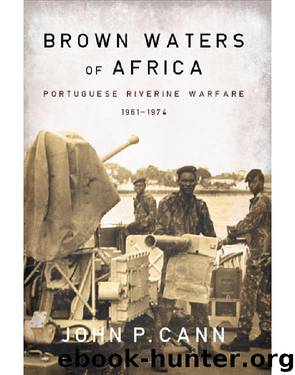Cann by Brown Waters of Africa; Portuguese Riverine Warfare 1961-1974 (2013)

Author:Brown Waters of Africa; Portuguese Riverine Warfare, 1961-1974 (2013)
Format: epub
Published: 2014-03-11T04:00:00+00:00
56
John A. Marcum, The Angolan Revolution, Volume II, Exile Politics and Insurgent Warfare (1962–1976) (Cambridge, Mass.: MIT Press, 1978), 42.
5
A Grim, Torrid Stretch of Swamp and Jungle
Of the three theaters of operations, Guiné was the most complicated and most difficult. It was also the most important theater for the navy, for here its activities were vital not only on the tactical but also on the strategic level. The reason was quite simple. About 80 percent of all cargo and personnel within the theater moved on the water either by sea or through the river system. Only about 18 percent moved overland, and a mere 2 percent by air.1 In the final years of the war when road travel became difficult, fully 85 percent was waterborne. Water transport was equally as important for the PAIGC, and for this reason the policing of river traffic by the navy was as important as its transport role. The force that would prevail in Guiné would be the one that could successfully use the waterways to support its land operations while preventing the other from doing the same.2 As in Angola, the naval mission was to dominate the sea, coastal, and river lines of communication and deny their use to the enemy, support the army and the population with its waterborne transportation capability, and project power ashore.3 These objectives would be accomplished with the potent combination of LFs, LDs, and Fuzileiros to reduce the PAIGC and cut its men and their supplies that flowed into the country. As we shall see, the navy rose to the challenge, but was in part frustrated by an unresolved difference in approach with the army. Without such a resolution and a fully coordinated approach, it is doubtful that in the Guinean environment any divided force could be completely successful in securing the colony from a determined external foe.
A Complicated Theater
Guiné was the rump of what had originally been an expansive and rich enterprise operated by the Portuguese in the fifteenth and sixteenth centuries. The Guiné of these years stretched from its northern boundary of the Rio do Ouro in what today is Western Sahara to its southern boundary of Cape Santa Catarina just north of the Zaire River. The trade that was conducted along this coast that primarily bordered the Gulf of Guiné was centered in pepper, ivory, gold, and slaves, and the size of the commerce in these commodities gave rise to names for specific parts of the continent. For centuries they would be called the Grain Coast, for Guiné pepper was known as the “grains of paradise,” the Ivory Coast, the Gold Coast, and the Slave Coast. Over time competitors in the form of the Spanish, the Danish, the Dutch, the French, the British, the Belgians, and finally the Germans reduced Portuguese holdings so that by 1886 it was delimited to the Guiné of today.4
There is nothing simple about Guiné from the period of its discovery by the Portuguese to that of the conduct of their counterinsurgency campaign there between January 1963 and April 1974.
Download
This site does not store any files on its server. We only index and link to content provided by other sites. Please contact the content providers to delete copyright contents if any and email us, we'll remove relevant links or contents immediately.
| Africa | Americas |
| Arctic & Antarctica | Asia |
| Australia & Oceania | Europe |
| Middle East | Russia |
| United States | World |
| Ancient Civilizations | Military |
| Historical Study & Educational Resources |
The Radium Girls by Kate Moore(11639)
100 Deadly Skills by Clint Emerson(4700)
The Templars by Dan Jones(4561)
Rise and Kill First by Ronen Bergman(4553)
The Doomsday Machine by Daniel Ellsberg(4253)
The Rape of Nanking by Iris Chang(4025)
Killing England by Bill O'Reilly(3901)
Hitler in Los Angeles by Steven J. Ross(3803)
Stalin by Stephen Kotkin(3731)
12 Strong by Doug Stanton(3420)
Hitler's Monsters by Eric Kurlander(3172)
Blood and Sand by Alex Von Tunzelmann(3061)
Darkest Hour by Anthony McCarten(3019)
The Code Book by Simon Singh(2870)
The Art of War Visualized by Jessica Hagy(2845)
Hitler's Flying Saucers: A Guide to German Flying Discs of the Second World War by Stevens Henry(2626)
Babylon's Ark by Lawrence Anthony(2436)
The Second World Wars by Victor Davis Hanson(2423)
Tobruk by Peter Fitzsimons(2380)
